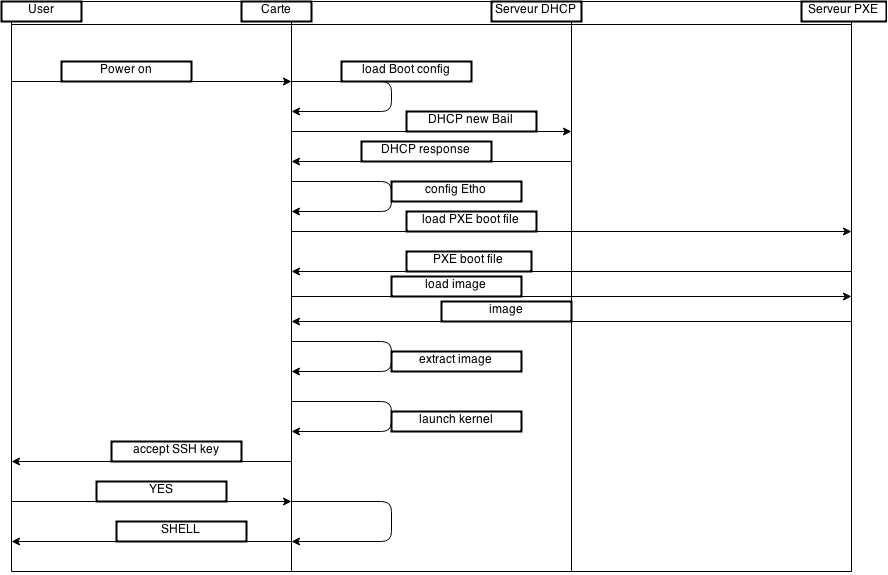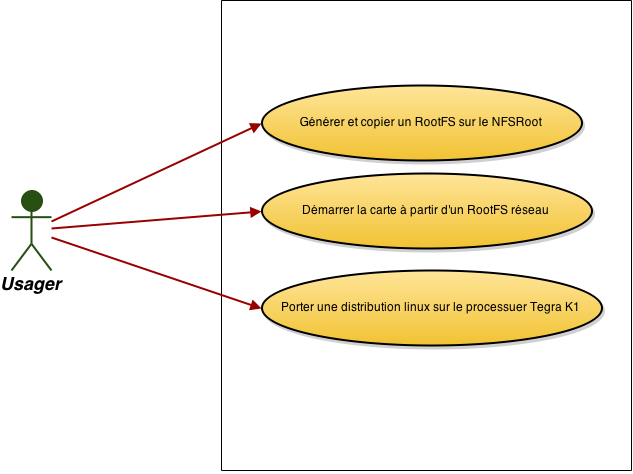Proj-2014-2015-Mini datacenter Systeme SRS
1. Introduction
1.1 Purpose of the requirements document
This Software Requirements Specification (SRS) identifies the requirements for this datacenter. The purpose of this document is to easily explain the development of this project and to provide instructions to understand and use the datacenter.
1.2 Scope of the product
The purpose of this project is to provide a mechanism and scripts to orchestrate the boot of the Jetson TK1 card from image OS store on an NFS Server in the datacenter.
1.3 Definitions, acronyms and abbreviations
- node
- datacenter
- frontend
- oar
- docker
1.4 References
- Get Started Jetson TK1
- Grid'5000
- OAR OAR is a versatile resource and task manager (also called a batch scheduler) for HPC clusters and other computing infrastructures. It's used on Grid'5000.
- oar-docker: oar-docker is a set of docker images especially configured for deploying your own OAR cluster. The main idea is to have a mini development cluster with a frontend, a server and some nodes that launch in just a few seconds on a simple laptop.
- Kameleon : Kameleon is a simple but powerful tool to generate customized appliances.
1.5 Overview of the remainder of the document
The SRS document includes 3 main chapters :
- General description, which contains the general characteristics of the project and our implementation choices.
- Specific requirements, which gives the main requirements of each function.
- Product evolution, which details the differents steps of implementation we chose.
2. General description
2.1 Product perspective
2.2 Product functions
2.3 User characteristics
L'utilisateur n'a pas besoin de connaître la façon dont s'instancie une ressource pour pouvoir utiliser l'interface.
2.4 General constraints
accès à la simulation dnas un environnement privé OAR-docker installé
2.5 Assumptions and dependencies
Chaque utilisateur ne travaille pas sur une même infrastructure, puisque les environnements sont privés.
3.Specific requirements, covering functional, non-functional and interface requirements
- document external interfaces,
- describe system functionality and performance
- specify logical database requirements,
- design constraints,
- emergent system properties and quality characteristics.
3.1 Requirement X.Y.Z (in Structured Natural Language)
Function:
Description:
Inputs:
Source:
Outputs:
Destination:
Action:
- Natural language sentences (with MUST, MAY, SHALL)
- Graphical Notations : UML Sequence w/o collaboration diagrams, Process maps, Task Analysis (HTA, CTT)
- Mathematical Notations
- Tabular notations for several (condition --> action) tuples
Non functional requirements:
Pre-condition:
Post-condition:
Side-effects:
4. Product evolution
5. Appendices
This document is inspired of the IEEE/ANSI 830-1998 Standard.
References:
- http://www.cs.st-andrews.ac.uk/~ifs/Books/SE9/Presentations/PPTX/Ch4.pptx
- http://en.wikipedia.org/wiki/Software_requirements_specification
- IEEE Recommended Practice for Software Requirements Specifications IEEE Std 830-1998


